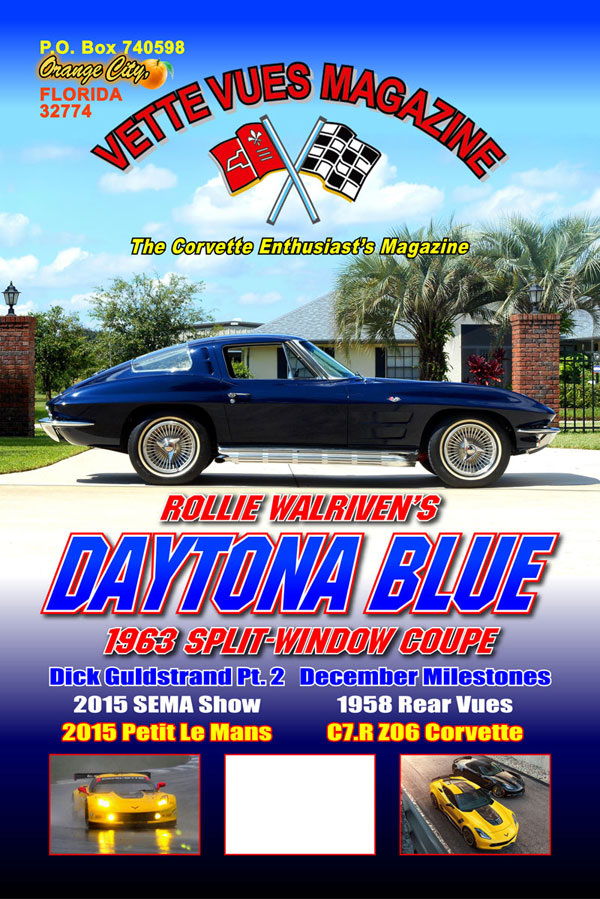Rollie Walriven, the single-owner of a Daytona Blue 1963 Split-Window Coupe
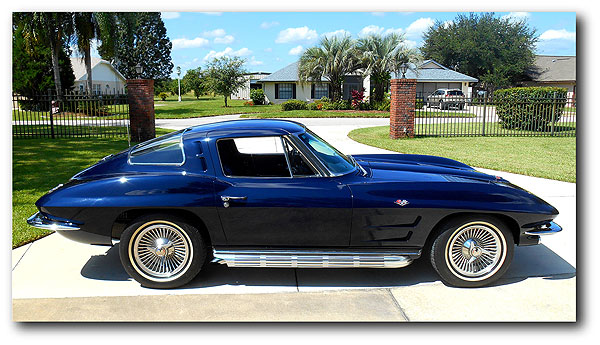
Dateline: 7.5.17 (This story was first published in the December 2015 issue of Vette Vues Magazine). We’ve all heard and perhaps have lived this story: Young man buys a Corvette, has a blast with the car, falls in love, marries, it’s time for a house, and the Vette is out’a here! “Life” often gets in the way of Corvettes. This is not one of those stories – no, just the opposite.
When Rollie Walriven took delivery of his brand new, Daytona Blue 1963 Corvette Coupe in November 1962, he was already a serious car guy. He had owned a daily driver 1959 4-speed Corvette with a mildly worked engine. He also had a basket case ’57 Corvette that he eventually built into a B/Production racecar that he started racing in 1964.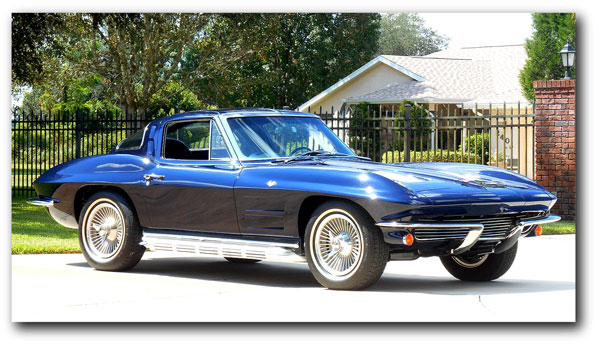 Rollie was a typical post WW II car crazy kid. Of course his uncle’s dirt track racing in the Ohio region helped stoke Rollie’s interest in cars and racing. Rollie got his first car in high school, a 1939 Ford. Then he got a Model A Coupe that had been made into a hot rod. The top was seriously chopped and the 104-HP engine had Stromburg carbs.
Rollie was a typical post WW II car crazy kid. Of course his uncle’s dirt track racing in the Ohio region helped stoke Rollie’s interest in cars and racing. Rollie got his first car in high school, a 1939 Ford. Then he got a Model A Coupe that had been made into a hot rod. The top was seriously chopped and the 104-HP engine had Stromburg carbs.
Back in the days of the military draft, military duty was a strong possibility for most young men. The Army worked out great for Rollie because they trained him in auto repair. After his discharge from the Army, Rollie worked at a few industrial companies before settling into a company that made industrial-size valves. He started with the company in 1956 and was eventually promoted to plant superintendent. Rollie was in the industrial valve business for 40 years.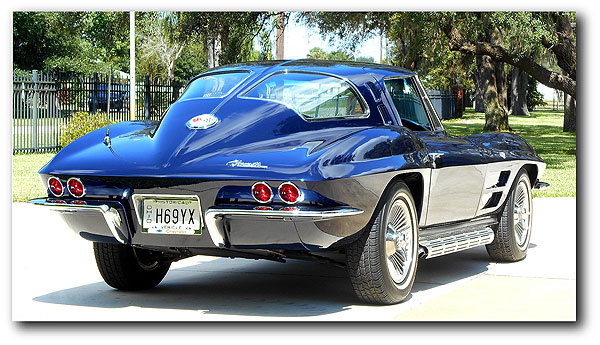 When Rollie first got into the world of Corvettes, people bought the cars because that was the kind of car they wanted to drive every day. But back then there weren’t that many Corvettes on the road and that’s when the “Save the Wave” thing got started. Corvette drivers would wave to acknowledge their ownership of a unique American car with a simple “wave” gesture.
When Rollie first got into the world of Corvettes, people bought the cars because that was the kind of car they wanted to drive every day. But back then there weren’t that many Corvettes on the road and that’s when the “Save the Wave” thing got started. Corvette drivers would wave to acknowledge their ownership of a unique American car with a simple “wave” gesture.
At the same time, communities of owners were sprouting up all over America – Corvette Clubs. Rollie joined the community when he bought his first Corvette, a new, black 1960 with a standard 283/230 engine and a 3-speed transmission. When he found a 1959 Corvette with a 4-speed transmission and a .030-over “worked” engine, he traded in the ’60 for a ’59. SCCA racing was big in the mid-west and Rollie worked in the timing tower at numerous racing events. By 1962 he was the president of the Queen City Corvette Club.
The 1963 Corvette was a total game-changer. While the engine and transmissions were carry-overs from 1962, the 1963 Corvette finally had a really good suspension. Four-wheel independent suspension was standard on all Corvettes – only exotic European cars had four-wheel independent suspension. But it was the new body styling that went straight to the heart. To appreciate the 1963 Corvette coupe and convertible you have to look at other cars from 1963. The new Vette looked like “The Future!” Rollie got right in line at his local Chevrolet dealership, placed his order in September 1962, and took delivery in November 1962.
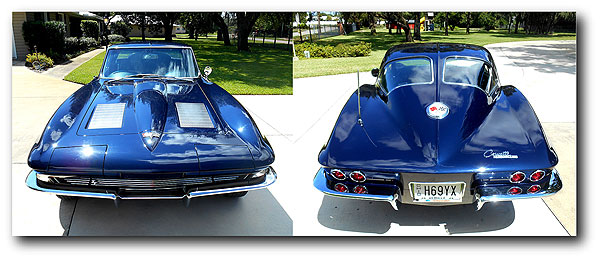 Rollie’s car is one of 21,513 Corvettes built in 1963 and one of 10,594 coupes for that year. The option list in 1963 wasn’t as extensive as it is today, but a Corvette could be ordered from a mild 327/250 with a 2-speed Powerglide or a rip-snort’n 327/360 Fuelie with the Z06 racing suspension and 36-gallon fuel tank. Creature comforts such as air conditioning, power steering, brakes, and windows, and AM/FM radio were available. Rollie checked off the L76 327/340 engine with a 4-speed, signal-seeking AM radio, and Daytona Blue paint. The total price of the car was $4,814
Rollie’s car is one of 21,513 Corvettes built in 1963 and one of 10,594 coupes for that year. The option list in 1963 wasn’t as extensive as it is today, but a Corvette could be ordered from a mild 327/250 with a 2-speed Powerglide or a rip-snort’n 327/360 Fuelie with the Z06 racing suspension and 36-gallon fuel tank. Creature comforts such as air conditioning, power steering, brakes, and windows, and AM/FM radio were available. Rollie checked off the L76 327/340 engine with a 4-speed, signal-seeking AM radio, and Daytona Blue paint. The total price of the car was $4,814
Duntov had been the Corvette’s front man since 1957 and not only did he make sure there were racing parts available, but he encouraged his customers to not just enjoy their Corvette, but to race their Corvette. There are many strata’s in racing – everything from the super speedways such as Daytona and international road racing tracks such as Le Mans all the way down to local drag racing and parking lot auto-cross racing. Rollie’s Corvette club built a one-plus-mile road course in a 28-acre cornfield, owned by a local farmer in Southern Indiana. The farmer wasn’t using the field and didn’t mind the Corvettes kicking up a lot of dirt, so Rollie and his club members enjoyed cornfield racing!
Cornfield racing can have strange effects on a Corvette. After a weekend of cornfield fun, Rollie noticed that the clutch wasn’t engaging right, so he took it to his local Chevy dealers service department. The mechanic asked what he’s been doing with the car and Rollie explained that he was doing a little weekend racing. The mechanic asked, “Racing in what? Your bellhousing is almost full of dirt.” The dirt was cleared out and Rollie and his Corvette went on their happy way. Yea, Chevy!
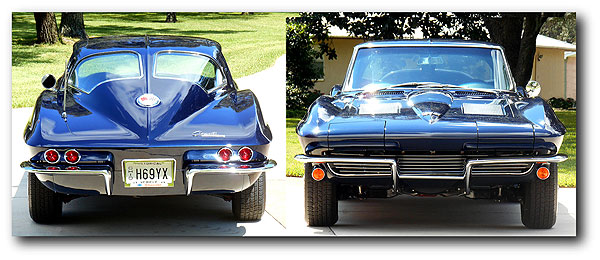 But Rollie did learn an important lesson: If you want to race, don’t use your streetcar. Rollie knew from driving his street Corvette that the new Sting Ray was THE platform to race, so he parked and eventually sold his 1957 Corvette racer, and bought a wrecked 1965 Corvette convertible to build into an SCCA B/Production racecar. Thus began Rollie’s serious racing period that we’ll get to later.
But Rollie did learn an important lesson: If you want to race, don’t use your streetcar. Rollie knew from driving his street Corvette that the new Sting Ray was THE platform to race, so he parked and eventually sold his 1957 Corvette racer, and bought a wrecked 1965 Corvette convertible to build into an SCCA B/Production racecar. Thus began Rollie’s serious racing period that we’ll get to later.
The beautifully restored car you see here is “the” car Rollie bought in November 1962. Aside from a few accessory parts, everything on the car today was there from the factory. We should consider this car as a personalized, restored, one-owner survivor car. There’s something you don’t see every day! From November 1962 to 1968 while Rollie was working for an industrial valve company, his 1963 Corvette was his daily driver that proved to a very dependable car. Sometimes the car even served as the tow car while Rollie was racing his 1957 Corvette.
After 1968, “the times, they were a’changing.” Rollie was driving the Corvette less and less. He’d started a family but was still able to race, so a family Chevy Suburban became his main mode of family and race car transportation. In 1973 Rollie was building a new house and “almost” sold the Corvette! This is often where Corvette can slip away for decades and sometimes forever. Yes, Rollie’s Corvette dodged the bullet, but the car sat in the garage more and more as the years rolled on and Life got in the way. From 1973 to 1999 Rollie says he drove the car, maybe 10 times.
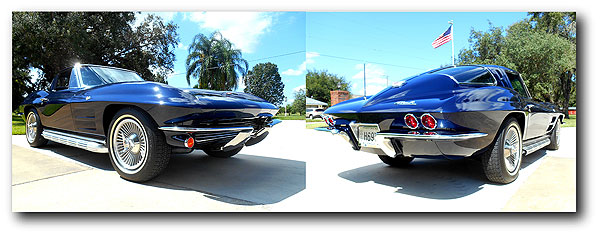 Rollie’s racing career stretched from 1965 to 1985. From 1964 to 1967 he raced his 1957 and then from 1968 to 1972 he raced his 1965 B/Production Roadster. During the time of 1972 to 1974 Rollie was busy with his family and building their new house, so there was no racing. But IMSA racing was getting so hot. Rollie decided to build an all-out 1970 IMSA Camaro and raced the car from 1976 to 1977 with the sole objective of running the 1977 12 Hours at Sebring race. Unfortunately, after three hours, the co-driver crashed the car, putting the team out of the race. Rollie still owns the Camaro and his son is currently restoring the car.
Rollie’s racing career stretched from 1965 to 1985. From 1964 to 1967 he raced his 1957 and then from 1968 to 1972 he raced his 1965 B/Production Roadster. During the time of 1972 to 1974 Rollie was busy with his family and building their new house, so there was no racing. But IMSA racing was getting so hot. Rollie decided to build an all-out 1970 IMSA Camaro and raced the car from 1976 to 1977 with the sole objective of running the 1977 12 Hours at Sebring race. Unfortunately, after three hours, the co-driver crashed the car, putting the team out of the race. Rollie still owns the Camaro and his son is currently restoring the car.
After Sebring, Rollie was basically done with road racing and from 1978 to 1985 drove late-model stock cars, mostly at the Queen City Speedway ½-mile oval track. After 1985 Rollie said, “Enough.” And was done racing, but his interest and passion continued on and rubbed off on his son. There’s a process for getting into SCCA racing, so Rollie helped get his sons Mark and Dale get into the game. In 1998 Rollie crewed for the Doran Racing Team that was campaigning Ferrari and Daytona Prototypes
By the end of the 1990s the ’63 Coupe was getting pretty tired. Rollie didn’t want to sell the car and since he was semi-retired he decided that a full frame-off restoration was the right thing to do. The plan was to make the finished car, “better than new.” Since the car was essentially completely intact as it was the day Rollie took delivery, everything was refreshed or replaced with period correct aftermarket parts. But he did add some personalization details that are so factory-based, and blend with the car, it all looks official.
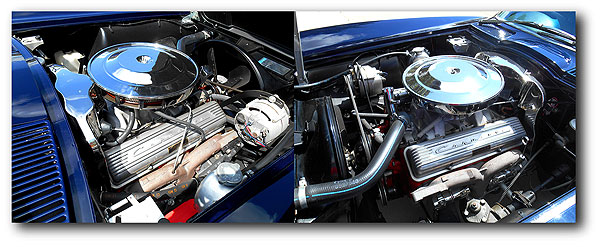 While Knock-Off wheels were on the official 1963 Corvette order form, Chevrolet and Kelsey-Hayes had a terrible time getting the tires to seal properly with the cast aluminum rim of the wheels. Chevrolet records show only 12 sets sold with a Corvette and several more sold over-the-counter. Knock-Offs were readily available by 1964 and were sold for $322 for the set of four. By 1967 the price was down to just $263. Rollie’s Knock-Offs are shod with Mileage Maker Radials with 1-inch-wide white walls. They’re slightly oversized, but not so much that they don’t look right and provide a world of difference in the driving experience.
While Knock-Off wheels were on the official 1963 Corvette order form, Chevrolet and Kelsey-Hayes had a terrible time getting the tires to seal properly with the cast aluminum rim of the wheels. Chevrolet records show only 12 sets sold with a Corvette and several more sold over-the-counter. Knock-Offs were readily available by 1964 and were sold for $322 for the set of four. By 1967 the price was down to just $263. Rollie’s Knock-Offs are shod with Mileage Maker Radials with 1-inch-wide white walls. They’re slightly oversized, but not so much that they don’t look right and provide a world of difference in the driving experience.
For “factory original” enthusiasts’, the most glaring deviation from stock is the inclusion of the factory side pipes. The Side-Mount Exhaust System (RPO-N14) wasn’t available until 1965 and cost just $134! To Rollie (and many others) the side-pipes looked perfect – as if they SHOULD have been available in 1963. So, Rollie added them to his “better than stock” restoration.
With the car totally apart, Rollie had everything rebuilt to factory specs, with very few exceptions. For practicality, he installed a Pertronix electronic ignition. With no points and 30,000 volts of spark, the car has no problem starting after sitting a few months. After the car was completely reassembled, it was treated to a four-wheel alignment – something it had never had before.
Of course, restorations can seem like they’ll never be completed. Rollie says, “I’m down to just the small things. I recently spent $1,000 to have the seat belts and buckles restored, year correct. And there are a few other really small things left to do. Rollie says, “As the car is today, it is truly a better car than the day I bought it!” What Rollie didn’t know in the beginning of the project was that the restoration of his $4,814 Corvette would cost a little over $40,000!
Rollie and his wife Nel moved from Ohio to south-central Florida, just above Sebring in 2005. They enjoy taking the car to local shows and for occasional drives. Now, why not drive and enjoy a “better than new” 1963 Corvette Split-Window Coupe, more? Well, the Walriven’s also own silver 2006 Z06.
About the C6 Z06 Rollie says, “The Z06 is more race car than street car. However, I have to say that my wife and I find the car to be very comfortable. The acceleration, handling and braking are amazing. We take trips and on the highway with cruise control that Z06 can get 30-mpg!” It’s my favorite Corvette.”
Rollie might be “old school” but he’s obviously comfortable with the new wave. His background and experience with Corvettes on the track has only heightened his appreciation for how far the Corvette has come since his first Corvette back in 1960. Rollie Walriven and Corvettes have been together since 1960 – going on 56 years. That’s what I call, a long-term friendship! – Scott
This story was first published in the December 2015 issue of Vette Vues Magazine.


